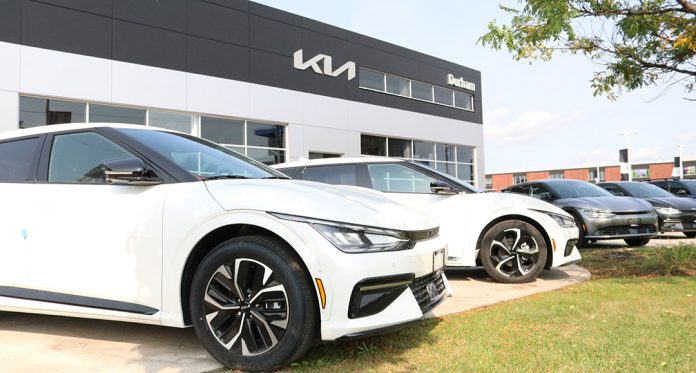In recent years the electric vehicle (EV) market has been steadily growing, offering a cleaner option of transportation for people.
With concerns of climate change, EVs have become central to discussions about slowing it down. However, the EV market still faces quite a few challenges, from the infrastructure of charging stations to public perception. In looking at how EVs compare to gas-powered vehicles, a key question emerges: What does the future hold for this rapidly evolving industry?
The rise in popularity of EVs can be credited to environmental concerns, government regulations and advancements in battery technology.
Lucas Rice, a sales professional at Durham Kia explained that they’ve been selling EVs for about two years. “Tesla was the first company to really come out with it, and it’s still very new. For us, we only know so much within the last two years, but so far, it’s been good. It’s been something that a lot of people want to get ahead of, and you save a lot on gas, too.”
The shift from gas vehicles to EVs is not only influenced by environmental impacts but also the idea of spending less money on gas. EVs cost significantly less to fuel compared to gas-powered vehicles, adding roughly an eight to ten dollar monthly increase on your electricity bill.
However, there are still some factors that are holding some people back from buying an EV. Infrastructure is a big issue in certain regions, with the availability of charging stations remaining a challenge.
While cities such as Toronto, Oshawa, and Whitby have many chargers that are readily available, a lot of rural areas are still lacking in that department. Rice noted that in smaller more rural places such as Port Perry and Bowmanville, EV owners “have to do a little bit more hard searching to find one.” The infrastructure gap means that anyone living outside of a larger city that owns an EV will likely have a lot more trouble finding a place to charge away from home.
Apart from infrastructure, another issue is the performance of EVs when the weather starts to change. According to Rice, KIA EV cars have a range of anywhere from 450 to about 490 kilometres on a full charge. “In the summer, you can get a range of about 70 to 100 kilometres more than that,” he said. “(But) in the wintertime, you’re going to lose about 30 per cent of your charge.”
The loss of range in colder temperatures is a drawback that’s difficult to ignore for EV owners that live in colder areas of the world like Canada, where a vehicle’s reliability is important during the winter months.
Dean McGilvray, a Class-A mechanic, brought another concern to light when it comes to maintenance. While EVs have a lot less day-to-day maintenance than a gas-powered car, the costs will likely be higher when things do go wrong.
“If something goes wrong in an EV, it can cost a heck of a lot more than a gas car because the dashboard in an EV car alone is about half the cost of the full vehicle,” said McGilvray. With EV cars running differently than gas vehicles, EV repairs will often be more expensive due to the need for specialized equipment and training.
Despite these challenges, the EV market has made significant strides in recent years.
Modern EVs are more efficient and more powerful than ever before. Some models, like Kia’s performance EV, run up to 450 horsepower, which is capable of going from zero to 60 in under three seconds, which would keep up with a high-end sports car. This level of performance, combined with the benefits of an environmentally friendly vehicle, makes EVs a solid option for city driving, where their regenerative braking systems excel at recapturing energy during stop-and-go traffic.
Nevertheless, many potential buyers remain cautious. Rice points out that while EV sales had a big surge when they were first released, they have since levelled out.
“People still want to go with what they know, versus what they want to find out. The whole guinea pig term, I think, is very much in effect right now,” he said, referring to the hesitation many consumers feel about being an early adopter of the new technology.
Looking ahead, the future of EVs depends heavily on the continued advancements of the battery technology and charging infrastructure. As McGilvray noted, “Better range is the only thing they could do better. We’re definitely not seeing enough range to suit most customers, especially those who are high-mileage drivers.”
Extending the range of EVs would make them a better option for long-distance travel and would reduce the need for frequent charging.
Despite some of the current limitations that EVs have, they still hold great promise. They offer a cleaner and more sustainable option than gas cars, and EVs are gaining momentum and could become the dominant form of transportation in the years ahead, as long as they invest in the right areas.




